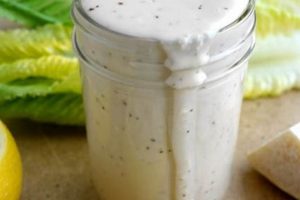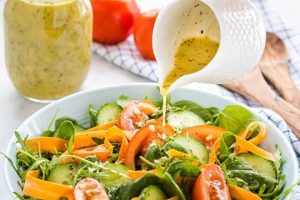Emulsified mixtures of healthy fats like extra virgin olive oil, often combined with acidic components such as lemon juice or red wine vinegar, characterize dressings aligned with Mediterranean dietary principles. These dressings frequently incorporate fresh herbs like oregano, basil, or mint, and may include ingredients like garlic, Dijon mustard, or capers for added flavor complexity. A typical example might involve whisking together olive oil, lemon juice, minced garlic, dried oregano, salt, and pepper.
Dressings based on these principles offer several nutritional advantages. Olive oil, a cornerstone of the Mediterranean diet, provides monounsaturated fats associated with cardiovascular health. The inclusion of fresh herbs and spices contributes antioxidants and other beneficial phytochemicals. Furthermore, such dressings enhance the flavor and enjoyment of fresh vegetables, encouraging higher consumption of these nutrient-rich foods. Historically, these flavor profiles have been prevalent in the cuisines bordering the Mediterranean Sea, reflecting the readily available local ingredients and a culinary emphasis on simplicity and freshness. This culinary tradition is increasingly recognized for its potential health benefits.
This exploration will delve deeper into the core components of these dressings, offering variations and specific recipes, and discussing their role within the broader context of the Mediterranean diet and its positive impact on well-being.
Tips for Crafting Exceptional Mediterranean Diet Salad Dressings
Creating flavorful and healthful dressings aligned with Mediterranean diet principles involves careful ingredient selection and mindful preparation techniques. The following tips offer guidance for achieving optimal results.
Tip 1: Prioritize High-Quality Olive Oil: The foundation of an excellent Mediterranean dressing lies in using extra virgin olive oil. Opt for a robust, flavorful oil with a low acidity level.
Tip 2: Embrace Fresh Herbs and Spices: Freshly chopped herbs like oregano, basil, mint, and parsley contribute vibrant flavor and valuable nutrients. Dried herbs can be substituted when fresh options are unavailable, but use them sparingly as their flavor is more concentrated.
Tip 3: Explore Citrus Variety: While lemon juice is a classic choice, other citrus fruits such as lime, orange, or grapefruit can offer unique flavor profiles. Experiment to find preferred combinations.
Tip 4: Balance Acidity: Achieving a harmonious balance between the oil and acidic components is essential. Start with a smaller quantity of acid and adjust to taste, avoiding excessive tartness.
Tip 5: Incorporate Flavorful Additions: Ingredients like minced garlic, shallots, Dijon mustard, capers, or crumbled feta cheese can add depth and complexity.
Tip 6: Emulsify Thoroughly: Whisk the dressing vigorously to create a stable emulsion that prevents separation of the oil and other ingredients. Alternatively, a blender or food processor can be used for a smoother, more homogenous texture.
Tip 7: Season Judiciously: Sea salt and freshly ground black pepper enhance the flavors of the other ingredients. Taste and adjust seasoning as needed.
By following these guidelines, one can consistently create flavorful, healthful dressings that complement a wide variety of salads and contribute to the overall benefits of a Mediterranean-style diet.
These practical tips lay the groundwork for exploring specific recipes and incorporating these dressings into a balanced and enjoyable dietary approach.
1. Ingredients
Ingredient selection is paramount in formulating a genuine Mediterranean diet salad dressing. The core components, primarily extra virgin olive oil, form the foundation of these dressings, providing monounsaturated fats linked to cardiovascular health. Beyond olive oil, acidic elements like lemon juice, red wine vinegar, or balsamic vinegar contribute brightness and balance. Fresh herbs, such as oregano, basil, mint, parsley, and dill, infuse the dressing with aromatic complexity and offer antioxidant benefits. Garlic, shallots, and capers introduce pungent notes, while ingredients like Dijon mustard or tahini provide emulsification and nuanced flavor. The synergistic interplay of these components defines the characteristic taste and nutritional value.
Consider a classic Greek salad dressing: extra virgin olive oil combined with lemon juice, dried oregano, and a pinch of salt. This simple combination exemplifies the Mediterranean diet’s emphasis on fresh, minimally processed ingredients. Alternatively, a more complex dressing might incorporate red wine vinegar, minced garlic, Dijon mustard, and chopped fresh parsley. The variability within these core ingredients allows for diverse flavor profiles while adhering to the fundamental principles of the diet.
Careful ingredient selection directly impacts the nutritional value and sensory experience of the final product. Opting for high-quality extra virgin olive oil maximizes the health benefits associated with its rich monounsaturated fat content. Fresh herbs provide not only vibrant flavor but also a source of antioxidants and other beneficial plant compounds. Understanding the role and interplay of each ingredient allows for the creation of dressings that are both flavorful and conducive to a healthy dietary pattern. This knowledge empowers informed choices, supporting both culinary enjoyment and well-being within the context of the Mediterranean diet.
2. Proportions
Achieving a well-balanced and flavorful Mediterranean diet salad dressing hinges on the correct proportions of its key components. The ratio of oil to acid, the amount of herbs and spices, and the inclusion of other flavoring agents all contribute to the final taste and texture. Understanding these proportions allows for consistent results and customization based on individual preferences.
- Oil to Acid Ratio
The balance between oil and acid forms the foundation of a vinaigrette. A classic starting point is a 3:1 ratio of oil to acid. This proportion provides a pleasant balance of richness and tartness. However, individual preferences may vary, and adjustments can be made based on the specific acid used and desired flavor profile. For example, lemon juice tends to be more tart than red wine vinegar, requiring adjustments in the ratio.
- Herb and Spice Incorporation
Herbs and spices contribute significantly to the flavor complexity of Mediterranean dressings. The quantity used depends on the potency of the herbs and spices themselves. Fresh herbs generally require a larger quantity than dried due to their milder flavor. A general guideline is to start with a smaller amount and adjust upwards based on taste, avoiding overpowering the other flavors.
- Emulsifier Content
Emulsifiers, such as Dijon mustard or tahini, help bind the oil and acid together, creating a stable emulsion. The amount of emulsifier needed depends on the other ingredients and the desired texture. Too little emulsifier may result in a dressing that separates quickly, while too much can create a thick, heavy consistency. Experimentation is key to finding the optimal balance.
- Additional Flavoring Agents
Ingredients like garlic, shallots, or capers introduce additional layers of flavor. The proportions of these ingredients should be carefully considered, as their flavors can be quite potent. Starting with small amounts and adjusting according to taste is recommended. Overuse can easily overshadow the more delicate flavors of the herbs and oils.
Mastering the proportions of these key elements allows for consistent creation of delicious and healthful Mediterranean diet salad dressings. By understanding the interplay between these components, one can tailor recipes to individual preferences and create dressings that perfectly complement a variety of salads and dishes, enhancing the overall Mediterranean dining experience.
3. Preparation Method
The preparation method of a Mediterranean diet salad dressing significantly influences its final texture, flavor, and stability. Different techniques yield distinct results, affecting how the ingredients combine and how the dressing coats and clings to salad components. Understanding these methods allows for greater control over the final product and ensures a dressing that complements the other flavors of the dish.
- Whisking
Whisking, the most common method, involves vigorously combining the ingredients with a whisk or fork. This creates a temporary emulsion, suitable for dressings used immediately. The simplicity of this method makes it ideal for quick preparations, although the emulsion may separate over time.
- Blending
Using a blender or food processor creates a smoother, more stable emulsion. The high-speed blending thoroughly incorporates the ingredients, resulting in a creamy texture and a dressing less prone to separation. This method is particularly effective for dressings containing thicker ingredients like tahini or yogurt.
- Mortar and Pestle
A traditional approach utilizes a mortar and pestle to grind ingredients like garlic, herbs, and spices before incorporating them into the dressing. This method releases the aromatic oils and flavors, enhancing the overall complexity of the dressing. It also allows for a more rustic texture.
- Marinating/Infusing
Flavor intensity can be amplified by marinating or infusing certain ingredients in the dressing. For example, allowing minced garlic to steep in the dressing for a period enhances its pungent flavor. Similarly, infusing herbs in the oil component before adding other ingredients can create a more aromatic and flavorful dressing.
The chosen preparation method contributes directly to the sensory experience and overall success of a Mediterranean diet salad dressing. Selecting the appropriate technique ensures the desired texture, emulsification, and flavor release. From the simplicity of whisking to the more complex process of mortar and pestle grinding, each method offers specific advantages, allowing for customization and adaptation to individual preferences and recipe requirements.
4. Flavor Profiles
Flavor profiles play a crucial role in the success of a Mediterranean diet salad dressing recipe. The hallmark of this dietary approach lies in the harmonious blend of fresh, vibrant flavors derived from high-quality ingredients. These flavor profiles are not merely incidental; they are a defining characteristic that contributes to both the palatability and the overall health benefits associated with the diet. The emphasis on fresh produce, herbs, spices, and healthy fats creates a complex interplay of tastes that elevates the sensory experience while promoting well-being.
Consider the interplay of olive oil, lemon juice, and oregano in a classic Greek salad dressing. The fruity, peppery notes of the olive oil combine with the bright citrus of the lemon and the earthy, slightly bitter oregano to create a balanced and refreshing flavor profile. This specific combination exemplifies the synergistic nature of Mediterranean flavors, where each ingredient complements and enhances the others. Alternatively, a dressing featuring red wine vinegar, garlic, and Dijon mustard offers a more robust and tangy profile. The sharpness of the vinegar, the pungent garlic, and the subtle heat of the mustard create a complex flavor dynamic that complements heartier salads and grilled vegetables. These distinct flavor profiles demonstrate the versatility and adaptability of Mediterranean cuisine.
Understanding the nuances of these flavor profiles allows for informed choices regarding ingredient selection and proportion adjustments. Recognizing the impact of individual components on the overall taste enables customization and creativity within the framework of the Mediterranean diet. The ability to balance acidity, sweetness, bitterness, and savoriness is key to crafting dressings that are both delicious and healthful. This knowledge translates into a more enjoyable and sustainable approach to healthy eating, emphasizing the importance of flavor as an integral component of a balanced diet. Moreover, the appreciation of these flavor profiles fosters a deeper understanding and appreciation of the culinary traditions of the Mediterranean region, encouraging exploration and enjoyment of a diverse range of healthy and flavorful dishes.
5. Health Benefits
Health benefits constitute a cornerstone of the Mediterranean diet salad dressing recipe framework. These recipes emphasize ingredients rich in monounsaturated fats, antioxidants, and anti-inflammatory compounds, contributing to overall well-being. Cause-and-effect relationships between these ingredients and improved health outcomes are well-documented. For instance, the extra virgin olive oil prevalent in these dressings provides monounsaturated fats linked to reduced risk of cardiovascular disease. The inclusion of fresh herbs and spices, such as oregano and basil, introduces potent antioxidants that combat oxidative stress and inflammation. This dietary pattern’s focus on whole, unprocessed foods further enhances its nutritional value. A simple lemon-herb vinaigrette drizzled over a salad of fresh vegetables not only enhances flavor but also delivers a concentrated dose of vitamins, minerals, and beneficial plant compounds. This exemplifies the practical significance of understanding the health benefits intrinsic to these recipes, transforming a simple culinary act into a proactive step towards improved well-being. Regular consumption of salads with such dressings can contribute to long-term health improvements, aligning with the broader goals of the Mediterranean diet.
Further analysis reveals that the health benefits extend beyond individual ingredients to encompass the synergistic effects of their combination. The antioxidants in herbs and spices, for example, enhance the absorption and utilization of nutrients from the vegetables. The olive oil facilitates the absorption of fat-soluble vitamins present in the salad ingredients. This interplay highlights the importance of considering the recipe as a whole rather than focusing solely on individual components. Studies indicate that adherence to a Mediterranean diet, including the regular consumption of these characteristic dressings, is associated with reduced risk of chronic diseases, including heart disease, type 2 diabetes, and certain types of cancer. These findings underscore the practical implications of incorporating these recipes into a regular dietary regimen. Choosing a Mediterranean-style dressing over a processed, high-fat alternative can significantly impact long-term health outcomes.
In summary, the health benefits associated with Mediterranean diet salad dressing recipes are substantial and multifaceted. These recipes, rich in beneficial fats, antioxidants, and anti-inflammatory compounds, offer a proactive approach to disease prevention and health promotion. Understanding the nutritional value and synergistic effects of these ingredients empowers informed dietary choices, facilitating the integration of a healthy and flavorful dietary pattern. While individual responses to dietary interventions vary, the evidence supporting the health benefits of the Mediterranean diet, including its characteristic salad dressings, remains compelling. Incorporating these principles into daily culinary practices can contribute significantly to long-term well-being.
Frequently Asked Questions
This section addresses common inquiries regarding Mediterranean diet salad dressing recipes, providing concise and informative responses.
Question 1: What distinguishes a Mediterranean diet salad dressing from other types of dressings?
Mediterranean diet salad dressings prioritize extra virgin olive oil as the primary fat source, incorporate fresh herbs and spices, and often utilize lemon juice or vinegar for acidity. These dressings generally avoid processed ingredients, refined sugars, and unhealthy fats.
Question 2: Can bottled dressings be considered compliant with Mediterranean diet principles?
While some bottled dressings may incorporate Mediterranean-inspired ingredients, many contain added sugars, preservatives, and unhealthy fats. Preparing dressings from scratch offers greater control over ingredients and aligns more closely with the diet’s emphasis on fresh, minimally processed foods.
Question 3: How can one adapt Mediterranean dressing recipes to accommodate dietary restrictions or allergies?
Adaptations for dietary restrictions are readily achievable. For example, maple syrup or honey can replace sugar, while specific herbs or spices can be omitted or substituted based on allergies or preferences. Ingredient lists should be carefully reviewed to ensure compliance with individual dietary needs.
Question 4: Are there specific types of salads best suited for Mediterranean dressings?
Mediterranean dressings complement a wide variety of salads featuring fresh vegetables, leafy greens, beans, and whole grains. They are also suitable for marinades, dips, and as a flavor enhancer for grilled vegetables or fish.
Question 5: How should Mediterranean salad dressings be stored, and what is their typical shelf life?
Homemade dressings are best stored in airtight containers in the refrigerator. Their shelf life typically ranges from one to two weeks, depending on the specific ingredients used. Separation may occur upon refrigeration; a gentle shake or whisk before use is often sufficient to re-emulsify.
Question 6: Beyond salads, how can Mediterranean dressings be incorporated into meals?
The versatility of these dressings extends beyond salads. They serve as excellent marinades for poultry, fish, or vegetables, adding depth of flavor. They can also be used as a dipping sauce for whole-grain bread or as a finishing drizzle for cooked grains or legumes.
By understanding these frequently asked questions, individuals can more effectively incorporate Mediterranean diet salad dressing recipes into their culinary practices, thereby enhancing both the flavor and nutritional value of their meals.
This concludes the FAQ section. Subsequent content will delve into specific recipe examples and practical tips for incorporating these dressings into a balanced Mediterranean diet.
Conclusion
Mediterranean diet salad dressing recipes represent a significant component of a dietary pattern associated with numerous health benefits. This exploration has examined the core elements of these recipes, emphasizing the importance of ingredient selection, proportions, preparation methods, and resulting flavor profiles. The analysis highlighted the nutritional advantages conferred by the use of extra virgin olive oil, fresh herbs, and spices, linking these components to reduced risk of chronic diseases and improved overall well-being. Furthermore, the discussion addressed practical aspects of preparation and customization, empowering informed choices regarding ingredient substitutions and adaptations for dietary restrictions.
The potential of Mediterranean diet salad dressing recipes to enhance both culinary enjoyment and health outcomes remains significant. Further research into the synergistic effects of specific ingredient combinations may yield additional insights into their health-promoting properties. Continued exploration of traditional Mediterranean culinary practices promises to uncover further variations and applications of these versatile and flavorful dressings, contributing to a richer understanding of their role in a balanced and healthful diet. Ultimately, the adoption of such recipes represents a tangible step towards embracing a dietary pattern that prioritizes both flavor and well-being.






